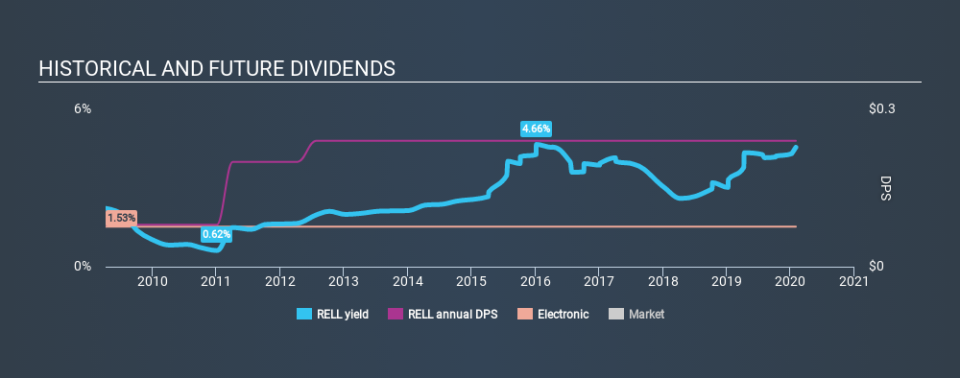Here's Why We're Wary Of Buying Richardson Electronics, Ltd.'s (NASDAQ:RELL) For Its Upcoming Dividend

Richardson Electronics, Ltd. (NASDAQ:RELL) is about to trade ex-dividend in the next 3 days. You can purchase shares before the 5th of February in order to receive the dividend, which the company will pay on the 27th of February.
Richardson Electronics's next dividend payment will be US$0.06 per share. Last year, in total, the company distributed US$0.24 to shareholders. Calculating the last year's worth of payments shows that Richardson Electronics has a trailing yield of 4.6% on the current share price of $5.27. Dividends are an important source of income to many shareholders, but the health of the business is crucial to maintaining those dividends. So we need to check whether the dividend payments are covered, and if earnings are growing.
Check out our latest analysis for Richardson Electronics
Dividends are typically paid out of company income, so if a company pays out more than it earned, its dividend is usually at a higher risk of being cut. Richardson Electronics's dividend is not well covered by earnings, as the company lost money last year. This is not a sustainable state of affairs, so it would be worth investigating if earnings are expected to recover. Considering the lack of profitability, we also need to check if the company generated enough cash flow to cover the dividend payment. If cash earnings don't cover the dividend, the company would have to pay dividends out of cash in the bank, or by borrowing money, neither of which is long-term sustainable.
Click here to see how much of its profit Richardson Electronics paid out over the last 12 months.
Have Earnings And Dividends Been Growing?
Stocks in companies that generate sustainable earnings growth often make the best dividend prospects, as it is easier to lift the dividend when earnings are rising. Investors love dividends, so if earnings fall and the dividend is reduced, expect a stock to be sold off heavily at the same time. Richardson Electronics was unprofitable last year, but at least the general trend suggests its earnings have been improving over the past five years. Even so, an unprofitable company whose business does not quickly recover is usually not a good candidate for dividend investors.
Another key way to measure a company's dividend prospects is by measuring its historical rate of dividend growth. In the past ten years, Richardson Electronics has increased its dividend at approximately 12% a year on average. Both per-share earnings and dividends have both been growing rapidly in recent times, which is great to see.
Remember, you can always get a snapshot of Richardson Electronics's financial health, by checking our visualisation of its financial health, here.
Final Takeaway
From a dividend perspective, should investors buy or avoid Richardson Electronics? We're a bit uncomfortable with it paying a dividend while being loss-making, especially given that the dividend was not well covered by free cash flow. Bottom line: Richardson Electronics has some unfortunate characteristics that we think could lead to sub-optimal outcomes for dividend investors.
Want to learn more about Richardson Electronics? Here's a visualisation of its historical rate of revenue and earnings growth.
We wouldn't recommend just buying the first dividend stock you see, though. Here's a list of interesting dividend stocks with a greater than 2% yield and an upcoming dividend.
If you spot an error that warrants correction, please contact the editor at editorial-team@simplywallst.com. This article by Simply Wall St is general in nature. It does not constitute a recommendation to buy or sell any stock, and does not take account of your objectives, or your financial situation. Simply Wall St has no position in the stocks mentioned.
We aim to bring you long-term focused research analysis driven by fundamental data. Note that our analysis may not factor in the latest price-sensitive company announcements or qualitative material. Thank you for reading.

 Yahoo Finance
Yahoo Finance 
